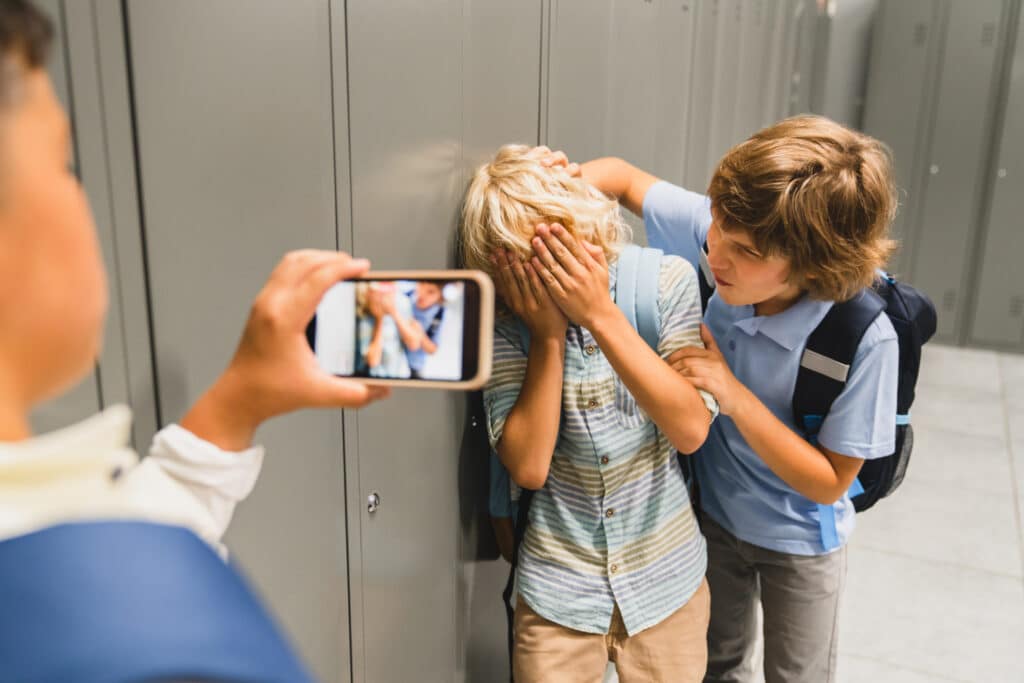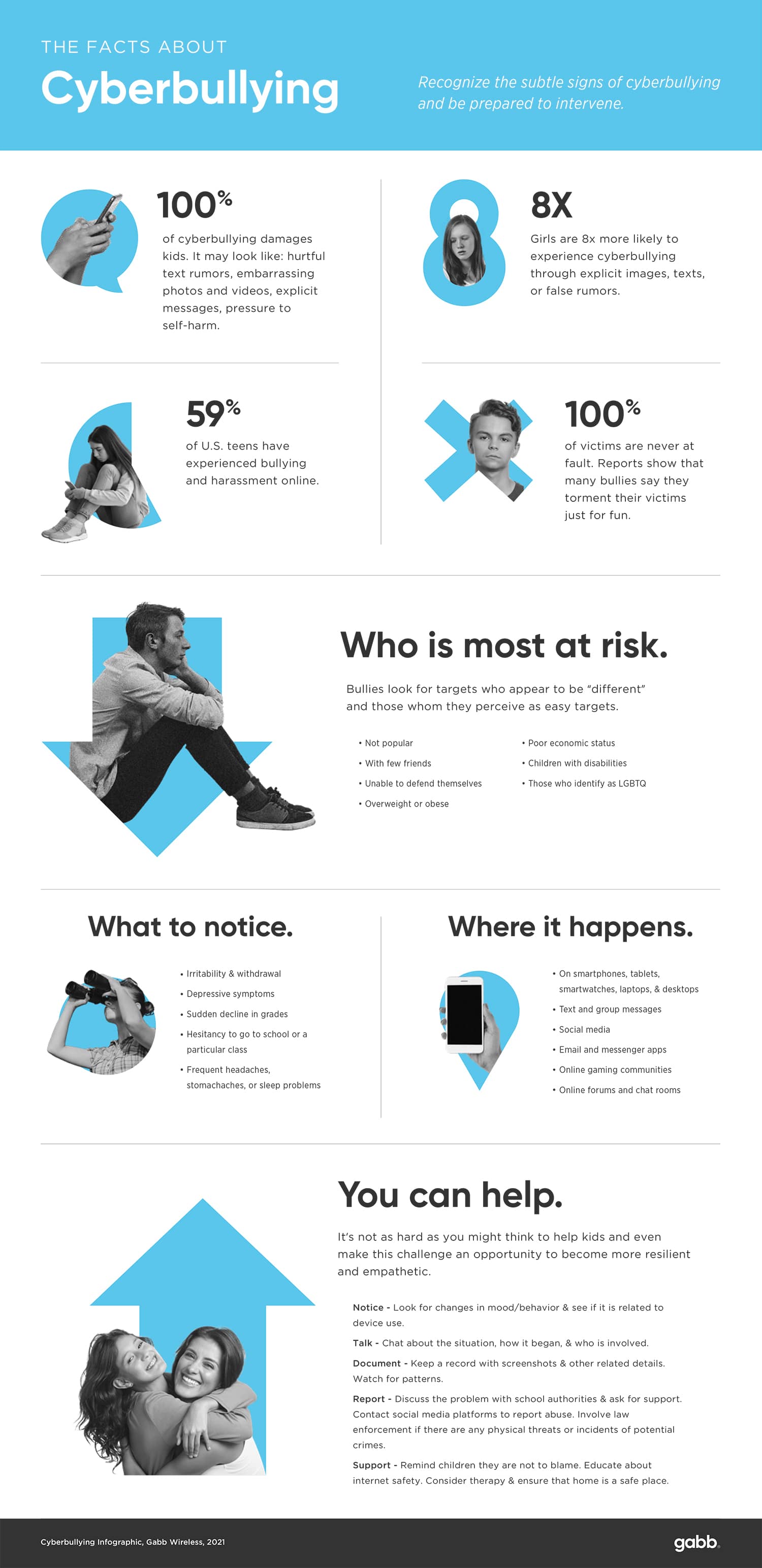In a rapidly-evolving digital world, parents can find it challenging to keep up with the newest platforms, apps, and online gaming.
Becoming equipped to recognize the signs of victimization is essential to keeping children safe. It will also provide an opportunity for you and your child to tackle problems together and grow closer in the process.
What is Cyberbullying?
Cyberbullying, or cyber-harassment, is using electronics to bully a person, such as sending intimidating texts or sharing humiliating videos on social media.
Experts in the field have brought to light the pervasiveness of cyberbullying. Even when there is not a compelling motive, there is ample opportunity to engage in damaging behaviors.
Examples of Cyberbullying
- Posting hurtful comments
- Encouraging victims to self-harm or commit suicide
- Threatening physical and social harm
- Posing as someone else with the intent of posting false information
- Creating an unflattering webpage about their victim
- Threatening to reveal personal information (doxing) such as addresses, social media handles, phone numbers, credit card information, and other private data [4]
Kid Stuff or Bullying?
There is a difference between being teased and being cyberbullied. Although teasing may involve some form of aggression, bullying is always aggressive and intends to intimidate, extort, or harm the victim.
Teasing often expresses a playful sentiment, but cyber-aggression stands in stark contrast—as its hallmark is cruelty.
Children need to distinguish between healthy forms of banter and online behavior intended to tear down, humiliate, and hurt the recipient [11].
Where Does Cyberbullying Take Place?
Cyberbullying manifests in myriad ways in the digital space. It can happen on apps such as TikTok, Instagram, Open, Whatsapp, and Snapchat. It occurs in video games including Call of Duty, Roblox, and Among Us.
Harassment of this kind is similar to traditional bullying and has the potential for exponential spread. According to the federally sponsored site, Stopbullying.gov, cyberbullying can occur on social media, text messages, instant messages, online chat, message boards, email, and online gaming communities [5].
“The tools of modernity enable the children and adolescents of today to paint unflattering pictures in a more remote, covert, and insidious manner.”
– Dr. Lucie Corcoran, lecturer of psychology at the Dublin Business School [13]
Group chats
An internet safety watchdog group in the UK surveyed 2,000 parents and discovered that 82% were concerned about bullying occurring via group chat. Group messaging is difficult for parents to observe as these chats are closed.
The impact of a shared bullying experience can cause profound hurt and encourage others to join in. Exploiting private messages or photos by disseminating them to a group is a common practice [6].
Single instance or repeated offense
Cyberbullying differs from face-to-face bullying in that it can occur between strangers and may occur repeatedly or involve only a single instance [3].
Be aware that a single instance of cruel teasing, while not appropriate, fails to meet the standard of aggression.
– Dr. Carol Bishop Mills, Professor and Director of the School of Communication and Multimedia Studies at Florida Atlantic University
Consider a scenario where an assault is recorded and then shared on social media. When a bystander captures the incident with the intent to astound their online followers rather than use the footage to aid police, aggression is implicit.

Cyberbullying and Self-Harm
Victims of cyberbullying are at a higher risk of self-harm and suicidal behaviors. [8] [12] Some teens believe that cyberbullying is worse than face-to-face bullying because the audience online is larger, attacks can happen relentlessly 24/7, and violations can be done anonymously. [14] [15]
Victims of bullying have an increased likelihood of suicidal ideation, attempts at self-harm, and completed suicides; they are nearly two times more likely to have attempted suicide. [13]
Tragically, cyberbullying has pushed children to suicide. A 15-year-old boy died by suicide after being cyberbullied at his private Chicago school.
Bullying and cyberbullying can happen together, such as a child being mocked or assaulted in person, and those events being filmed and shared online. This makes the humiliation of the in-person actions compounded, and the impact is lasting.
On the first of February, 2023, a 14-year-old girl in Florida took her own life after a video of her being assaulted in the halls of her high school was shared on social media. Bystanders laughed and filmed as she was kicked, punched, and mocked.
“Educators and parents should also be aware of the substantial stress bullying in the cyberworld places on young adolescents.”
– Dr. Ran Barzilay; Assistant professor at the Lifespan Brain Institute of Children’s Hospital of Philadelphia (CHOP). [12]

Why Kids Bully
As we know, sometimes there is no logical explanation for bullying. No type of cyber-aggression is warranted nor brought on by something intrinsic about the victim.
Research points to a disconnect when children act out in this way. Because cyberbullies commit this type of aggression from a distance, those who engage may experience a cloak of disinhibition.
Cyberbullies are not in physical proximity to their victims and therefore do not contextualize the social cues as they would if they were in direct contact. When “cyberbullies [are] physically and emotionally removed from their victims … they [do] not experience the impact of their actions” [16].
Motivations range from intolerance of race, gender identity, and sexual orientation or simply a misguided desire for the bully to feel better about themselves—many bullies concede that they choose to torment their victims just for fun.
– Kris Varjas, PsyD, Associate Dean for Graduate Studies and Research at Georgia State University [16]
Other external motivations vary — intolerance of race, gender identity, and sexual orientation or simply a misguided desire for the bully to feel better about themselves. Some children report an urge to enact revenge, and many concede that they choose to torment their victims just for fun [16].
If you suspect or know your child is engaging in bullying behavior, seek professional help. Good kids often make inappropriate decisions while growing up, but change is possible.

How Can I Tell if My Child Is Being Bullied?
Children may be too embarrassed or ashamed to talk to adults if they are being bullied. We can be proactive by learning the signs of bullying and fostering open communication with our children.
See the signs
Experts agree that a common experience most victims share is becoming agitated when they receive a notification on their device. This agitation signals anticipatory grief as kids steel themselves for aggression.
Parents may also notice depressive symptoms, such as a sudden decline in grades, a hesitancy to go to school or a particular class (often citing the reason as feeling too ill to attend), and appearing to feel less satisfaction from activities previously enjoyed [1].
What Parents Can Do
Children need to be able to petition parents for help when they are in distress. Consider the metaphor of teaching children to jump into the pool—a parent waits in the water with open arms, the child takes the plunge and the parent guides them to the safety of the wall.
Open communication
Establishing open communication between parents and children is critical to identifying cyberbullying when it happens. Many children feel ashamed of being bullied, so they often don’t tell their parents [2].
Fostering open communication will allow your child to feel safe enough to confide in you and have your help reaching a secure place to approach the problem.
– Maggie (Ledwell) Thorsen, Assistant Professor of Sociology at Montana State University
Likewise, fostering open communication will allow your child to feel safe enough to confide in you and have your help reaching a secure place to approach the problem.
Parents can check in with their children and ensure they aren’t bullying others. There are helpful resources for victims of cyberbullying.
We can use these conversation starters to identify the problem, help our children feel understood, and acknowledge their pain. We can also begin to form a plan in response to the aggressive behavior as we team up to address the situation.

Identify:
- You’ve seemed a little down lately. What’s been bothering you?
- You know we have an open phone policy, and I noticed today that someone sent you a pretty mean text. Tell me a little more about it.
- How long has this been going on? How have you handled it so far?
Acknowledge the pain:
- If someone had sent me that text, I think I would feel pretty upset. How are you feeling?
- If someone posted that about me, I would feel so embarrassed. How about you? What emotions have you been feeling?
- It’s not ok for someone to say these things to you.
Make a plan together:
- How long has this been going on? How have you handled it so far?
- What would you like to see happen?
- Let’s make a plan together. First, we’ll make a list of things that have been texted or posted.
- Let’s go ahead and block this contact right now. You should not have to feel anxious every time you get a notification.
- I suggest we contact (the child’s parents, school administrators, law enforcement). How might they help end the harassment?
- Together, we will put a stop to this.
Having ongoing conversations about the exchanges happening on your child’s devices will make it easier for them to talk to you when they are in crisis and for you to give counsel when you become aware of a problem.
Furthermore, “ … adolescents who can easily talk with their parents can process negative social experiences with them, and in turn, those experiences do not exert as strong of an effect on their internalizing behavior” [9].
Intervention
If you are concerned that your child is experiencing trauma, consult with your family physician to determine if professional support is needed. Once your child discloses to you what is happening, first collect facts by talking about the situation.
Be 100% sure you and your child agree on what the intended outcome and consequences of the plan to address the bullying may be.
– Common Sense Media, nonprofit organization dedicated to informing parents and educators
Next, create a plan of action together. Especially in these situations, kids benefit by feeling they have some input or control. Be 100% sure you and your child agree on what the intended outcome and consequences of the plan may be [18].

If your child is cyber-bullied by someone they know, consider speaking with that child’s parents. You may choose to approach them on your own, and you can also involve school administrators to support all parties through the process [18].
Show all parties that you are committed to finding a solution by expressing confidence that the perpetrator can make better choices.
Draw a firm boundary so that the behavior will not be tolerated. When you meet, encourage a discussion about digital permanence and its consequences as a way to deter future acts.
Reporting Abuse on Social Media
There are places on social media apps such as Instagram, Snapchat, TikTok, and Facebook to report cyberbullying. Look for “Safety Centers,” “Parent Information,” and “Community Guidelines.” You can report the bully, block them, or change who can contact your child.
If your child experiences cyberbullying via cell phone, block the number [18]. If you see threats or calls for your child to self-harm, immediately report the incident to school personnel and law enforcement. Take screenshots for evidence.
Stay up to date on parenting in the digital age by subscribing to Gabb Family Resources.
References
- [1] Anti-Defamation League. (n.d.). Cyberbullying Warning Signs. Bullying & Cyberbullying Prevention. Retrieved September 22, 2021, from https://www.adl.org/resources/tools-and-strategies/cyberbullying-warning-signs.
- [2] Common Sense Media. (n.d.). What should I do if My Kid is Bullied Online? Cyberbullying, Haters, and Trolls. Retrieved September 22, 2021, from https://www.commonsensemedia.org/cyberbullying/what-should-i-do-if-my-kid-is-bullied-online.
- [3] Corcoran, L. (2015). Cyberbullying or Cyber Aggression?: A Review of Existing Definitions of Cyber-Based Peer-to-Peer Aggression. Societies, 5(2), 245–255. https://doi-org.ezproxy.uvu.edu/10.3390/soc5020245
- [4] Department of Health and Human Services. (2018, May 10). Cyberbullying Tactics. StopBullying.gov. Retrieved September 21, 2021, from https://www.stopbullying.gov/cyberbullying/cyberbullying-tactics
- [5] Department of Health and Human Services. (2021, August 27). What is Cyberbullying. https://www.stopbullying.gov/cyberbullying/what-is-it.
- [6] Group Chat is the New Cyberbullying Threat. Internet Matters. (2018, December 18). Retrieved September 21, 2021, from https://www.internetmatters.org/hub/press_release/group-chat-is-the-new-cyberbullying-threat-as-8-out-of-10-parents-reveal-concerns/.
- [7] How do I report cyberbullying? Common Sense Media: Ratings, reviews, and advice. (n.d.). Retrieved September 16, 2021, from https://www.commonsensemedia.org/cyberbullying/how-do-i-report-cyberbullying.
- [8] Ledwell, M., King, V. (2015). Bullying and Internalizing Problems: Gender Differences and the Buffering Role of Parental Communication. SAGE Journals. Retrieved September 22, 2021, from https://journals.sagepub.com/doi/10.1177/0192513X13491410.
- [9] Lee, A. M. I. (2020, October 22). The Difference Between Teasing and Bullying. Retrieved September 22, 2021, from https://www.understood.org/articles/en/difference-between-teasing-and-bullying.
- [10] Mills, C. B., & Carwile, A. M. (2009). The Good, the Bad, and the Borderline: Separating Teasing from Bullying. Communication Education, 58(2), 276–301.
- [11] Varjas, K., Talley, J., Meyers, J., Parris, L., & Cutts, H. (2010, August). High school students' perceptions of motivations for cyberbullying: An exploratory study. The western journal of emergency medicine. Retrieved September 22, 2021, from https://www.ncbi.nlm.nih.gov/pmc/articles/PMC2941365/.
- [12] What is cyberbullying? Common Sense Media: Ratings, reviews, and advice. (n.d.). Retrieved September 14, 2021, from https://www.commonsensemedia.org/cyberbullying/what-is-cyberbullying.
- [13] What should I teach my kid about safe online behavior? Common Sense Media: Ratings, reviews, and advice. (n.d.). Retrieved September 16, 2021, from https://www.commonsensemedia.org/cyberbullying/what-should-i-teach-my-kid-about-safe-online-behavior.
- [14] When should parents intervene in a cyberbullying situation? Common Sense Media: Ratings, reviews, and advice. (n.d.). Retrieved September 16, 2021, from https://www.commonsensemedia.org/cyberbullying/when-should-parents-intervene-in-a-cyberbullying-situation.
- [15] Vaas, L. (2015, September 24). Cyberbullying is worse than face-to-face bullying, teens say. Naked Security. https://nakedsecurity.sophos.com/2015/09/24/cyberbullying-is-worse-than-face-to-face-bullying-teens-say/
- [16] Varjas, K., Talley, J., Meyers, J., Parris, L., & Cutts, H. (2010, August). High school students' perceptions of motivations for cyberbullying: An exploratory study. The western journal of emergency medicine. Retrieved September 22, 2021, from https://www.ncbi.nlm.nih.gov/pmc/articles/PMC2941365/.
- [17] What is cyberbullying? Common Sense Media: Ratings, reviews, and advice. (n.d.). Retrieved September 14, 2021, from https://www.commonsensemedia.org/cyberbullying/what-is-cyberbullying.
- [18] What should I teach my kid about safe online behavior? Common Sense Media: Ratings, reviews, and advice. (n.d.). Retrieved September 16, 2021, from https://www.commonsensemedia.org/cyberbullying/what-should-i-teach-my-kid-about-safe-online-behavior.
- [19] When should parents intervene in a cyberbullying situation? Common Sense Media: Ratings, reviews, and advice. (n.d.). Retrieved September 16, 2021, from https://www.commonsensemedia.org/cyberbullying/when-should-parents-intervene-in-a-cyberbullying-situation.









Success!
Your comment has been submitted for review! We will notify you when it has been approved and posted!
Thank you!